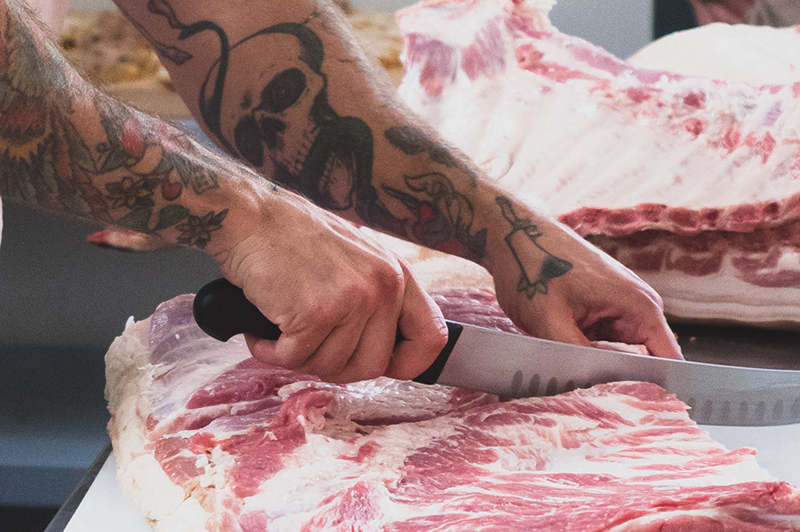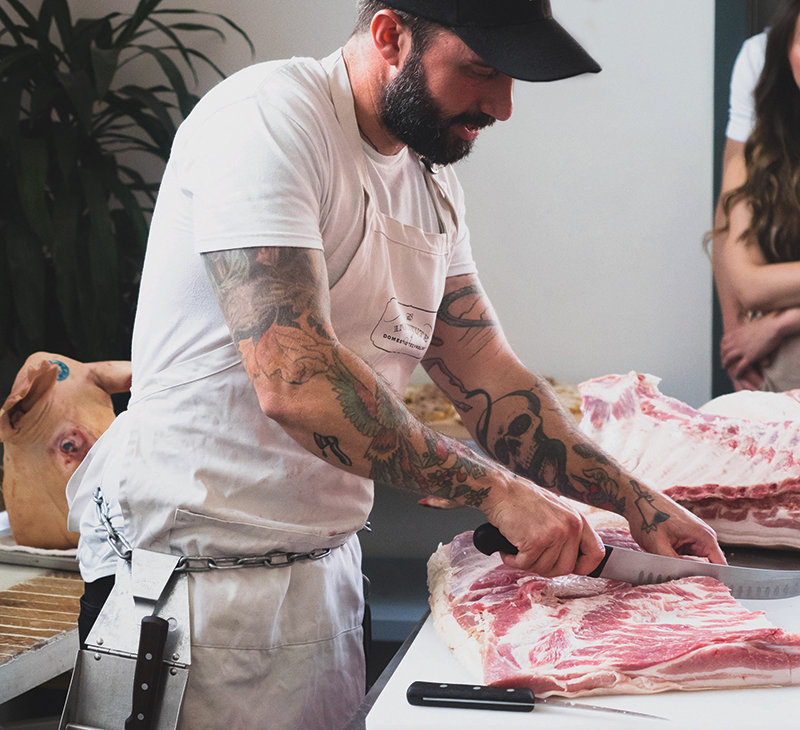
Chairman of the Board
From cost savings to curbing waste, Jered Standing schools us on the benefits of DIY meat butchering.
-
CategoryEat & Drink, People

Photographed by Jenn Pann
Jered Standing got into DIY butchery by accident. He was working at a grocery store where he says he learned “how ugly and awful” the meat industry could be. “I quit working there and struggled with the ethics of eating meat for a long time. When I decided to get back into butchering it was with the specific goal of doing something to affect positive change in the meat industry,” Jered says. His journey as butcher later landed him at Belcampo Meat Company, where he worked as Head Butcher and General
Manager, leaving recently to start the process of opening his own butcher shop. Jared is also working as an Instructor at The Institute of Domestic Technology, teaching butchering classes at Food + Shelter, an event space in northeast LA. Here Editor-in-Chief Linda Grasso queries the knife master on the art—and current craze—of home carving.
 Why has home butchering become so popular?
Why has home butchering become so popular?
Everything has become so industrialized that we feel really removed from the source of almost everything we eat or encounter in our daily lives. And as creative beings, this is really deeply unsatisfying. We all want to get our hands dirty sometimes.
What is the main benefit?
Saving money. Buying a whole chicken is way cheaper than buying parts. (Up to four times less expensive.) And if you know what to do with a pork shoulder or whole beef chuck you can really save some cash!
Other benefits?
The less tangible benefit of simply doing it yourself. It’s always a more satisfying experience to make something “from scratch.” Home butchery is the meat version of making dough, rather than buying a frozen piecrust.
What is the best way to learn to butcher meat?
YouTube! Seriously. You definitely need the hands-on experience as well, which is what my classes offer, but you really can get a huge head start from watching videos or reading books.
How does one begin?
Chickens are great for learning. The whole thing is edible. You really can’t do anything wrong.
When it comes to beef and pork, do home butchers order whole animals?
Most likely people aren’t order – ing whole hogs or sides of beef to butcher at home. When I say “home butchery,” generally I’m thinking large parts of animals— whole pork shoulders or legs, whole beef chuck or round.
How does one handle disposal of unused parts?
There should be no unused parts really. The only thing there should be to dispose of (aside from an ounce or two of connec – tive tissue or glands) is bones— after you’ve roasted and made a stock or broth from them. This will generally be a small quantity and can be thrown away in the garbage. There’s no biohazard situation or anything.
How do you assess freshness of meat?
I want to just avoid the question of “freshness.” Freshness really isn’t a word I would ever associate with meat. Proper handling is what’s important. And that’s where trust—which is also important—comes in. You have to trust not only that your butcher is doing the right thing, but that he/she knows what that right thing is.
For example, a three-day-old chicken that’s been properly air-chilled is going to be way better than one that was killed yesterday and shoved into a bag. Beef is far better if it’s been allowed to dry-age for several weeks before it is cut and prepared. And even pork and lamb do well with a few days, or up to a week, of hanging in the right environment.
How often do you have students who arrive and discover they’re squeamish?
Every time I teach I’m amazed by how well everyone does and how ready they are to really get into it. At my chicken classes, for example, I always put out a box of gloves, but I don’t think anyone has ever used them. They all seem very eager to get their bare hands on those birds!
Even when I’m showing how to take the jowl off of a pig head without piercing the cheek muscle, everyone just seems really fascinated. I mean that face is looking them right in the eye while I’m doing it!
I think it’s because they all know the reason behind what we’re doing: we want to use this whole animal in the most efficient, respectful way, with the least amount of waste possible.
I recently attended a beautiful dinner party and our host/chef put a whole fish head perfectly intact on the table. Some guests were a bit taken aback. Our host told me it was his way of giving a nod to the beauty of what was once a living creature. Thoughts?
I think it is definitely important for everyone to really acknowledge that the meat they’re eating was once a living being. But this can be done very privately for each individual. I don’t think it needs to be right in your face. For a lot of people seeing an animal’s face while they eat it (or even while they shop) is going to be really shocking.
What are your favorite cuts of meat?
For cuts of beef like New York or rib eye I like 21-50 days aged. My absolute favorite cut? Sausage!
For more on Jered (next class is July 30), go to instituteofdomestictechnology.com
Architect May Sung Comes to The Rescue on a Studio City Reno Gone Wild
In the right hands…finally!











